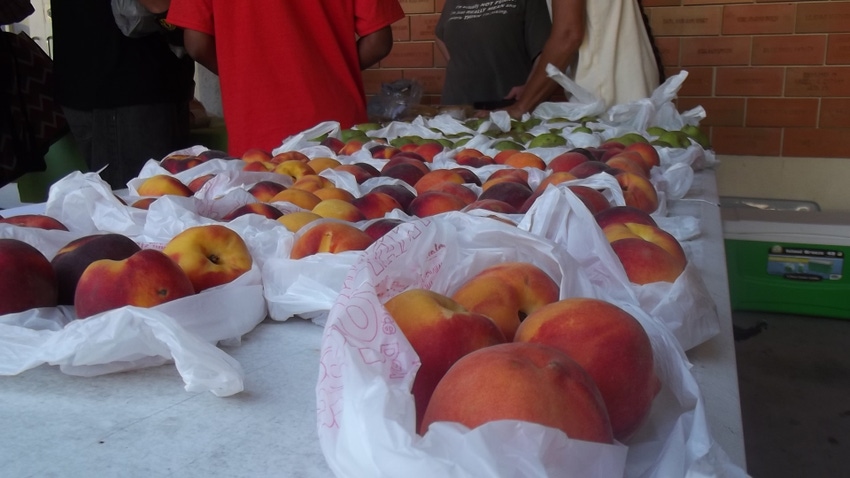
According to a 2014 study new opportunities exist for American farmers to provide a larger share of the growing demand for fresh fruits and vegetables, but statistics indicate U.S. producers continue to lose ground to foreign exporters.
Two recent studies released by the Partnership for a New American Economy (PNAE) indicate better informed and financially capable U.S. consumers are concerned how and where their food is grown, and suggest that it has created many opportunities for U.S. producers to help meet the growing demand for locally-grown and more secure fresh food products.
"The buy-local movement, which encourages consumers to support local or regional growers, has pushed many Americans to seek out local and U.S.-grown produce at farmers markets and grocery stores. Several recent high-profile fresh produce recalls involving imports have also made U.S. consumers more determined to buy food grown in America," both studies note.
For the latest on southwest agriculture, please check out Southwest Farm Press Daily and receive the latest news right to your inbox.
But in spite of those concerns and a rash of outbreaks of food borne illness this year, U.S. producers are failing to capitalize on those opportunities.
A recent widespread outbreak of Cyclospora caused by a single-celled parasite and shipped to U.S. markets from a producer in Mexico this year (2015) sickened an estimated 546 people in 31 U.S. states so far. A new and ongoing outbreak of Salmonella Poona infection linked to cucumbers grown in Mexico has sickened 418 people in the U.S. so far and has resulted in at least two deaths over the last two weeks.
Last week alone 15 new human cases of Salmonella related to cucumbers were reported in New Mexico, 11 new cases in Montana and multiple new cases including one death in Texas. Overall, 77 new cases have been reported nationwide over the last two weeks.
"From a business perspective, this presents U.S. growers with a real opportunity to expand their operations and contribute more to the country’s economic growth—potentially to a dramatic degree. In an era when the vast majority of Americans say they are concerned about food safety, domestic farms hold a real advantage," according to Stephen Bronars, Ph.D., Senior Economist, Welch Consulting, author of the studies.
In a report prepared for a coalition of 500 lawmakers from both sides of the political aisle and a group of independent mayors and business leaders, domestic produce growers have been largely unable to realize the benefits of this increased interest in U.S.-grown fresh fruits and vegetables for a number of reasons.
Immigration reform needed
From 1998 to 2012, a period when U.S. consumption of the major fresh fruits and vegetables rose significantly, the amount of fresh fruits grown in America increased only slightly and production of fresh vegetables actually declined, forcing American consumers to rely more on imported fresh foods.
The chief reason offered why U.S. food producers are not rising to the challenge for the demand of locally-grown fresh foods is a lack of available farm labor created by a broken immigrant worker program.
For example, in a report released last month, the PNAE notes that despite unemployment rates remaining high in some parts of the country, news reports have described farmers in Texas losing dozens of acres of carefully cultivated squash due to a lack of available field hands. In New Mexico, the annual green chile harvest currently underway is running short on farm laborers and to complicate the matter, nearby onion growers are competing for the same labor base.
The first of the two reports released also point to Georgia blackberries left to rot in the field while in California, asparagus and cantaloupe farmers were forced to abandon fields of healthy crops, even during a time of drought when crop yields were unusually low.
The conclusion to why more U.S. food producers are not taking advantage of the growing opportunities in the U.S. marketplace most often hinges on the availability of farm workers. Immigration reform, according to the latest study, is needed to allow a greater supply of willing farm laborers to work in U.S. fields, thereby offering farmers assurance that their fresh food crops will not be lost before being moved to market.
While other studies indicate the lack of farm labor is not the only blockade to greater production numbers for U.S. fresh food growers, it may be the chief concern for young farmers who often choose to grow grains, cotton or other crops that can be mechanically harvested instead of fresh vegetable and fruit crops that are more labor intensive.
On the positive side to U.S. consumer demand for domestic fruits and vegetables, small farms are expected to continue enjoy an upswing in success as consumers continue to favor locally-grown choices for their tables. Food co-ops and farmers’ markets are expected to continue their growth in popularity, and even more so as food security issues continue to plague the international food industry.
About the Author(s)
You May Also Like




